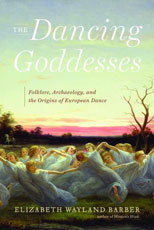"In that conservative, nonurban, and often precarious way of life, dance formed and still forms a sort of glue holding people and life together, bonding communities. It mediated life's joy, pain, hopes and fears, love, hate, tedium, and tingling expectation. Dance also marked off ritual time and space, served to anesthetize fatigue and heal sickness, and even sought to produce life. Dance was not an 'art form' but the essence of life itself.
"Among rural farmers, struggling to lay in enough plant and animal food to make it through another year, the encouragement of life — the process of germinating or hatching, then growing and bearing issue — was essential to survival. The reasoning, as we shall see, is roughly as follows.
"Life causes motion, and motion can give evidence of life. This becomes: 'Life causes motion, hence motion is evidence of life.' Humans can see that the motions of work have a direct purpose, but motion for motion's sake is something else — 'dance' broadly taken. (In the languages of eastern Europe, the same word often means both 'dance' and 'play,' and other nondirected motions like swinging, tickling, and laughing may fall in this basket. Medieval western Europeans, too, called the nocturnal dancing and feasting of the spirits the game, its goal being an abundance of crops called luck.) Supernatural powers, of course, need not work to survive; hence divine life simply 'dances' and in this very act of dancing is thought to create life.
"Enter the Dancing Goddesses, the repositories and creators of the fertility and healing powers so desperately needed for families, fields, and flocks to prosper. Their dancing created life, their wrath could destroy it. The spirits that villagers sought to influence were the spirits of the dead. But different categories of dead existed, with different powers and different connections to the living.
"First, one's dead ancestors. Since they had begotten the living, one could reasonably appeal to them to help their offspring survive. And because these ancestors had been buried in the ground (where their spirits were assumed to pass much of their time), presumably they could help the seeds down there — the newly sown crops — to germinate and grow. Basic to this belief is the notion of resurrection: the seed seems dead, it is buried, it rises to produce new seed. The eternal cycle of life.
"Second were the spirits of the dead of other villages. These were particularly dangerous because they would be busy sequestering all the existing abundance for their offspring. So ritual dancers, from the Balkans to Britain, marked out territories and fought intruding bands, to the death if necessary.
"Finally, there existed a very special group: young women born into the clan who had died before having any children — hence not ancestors of the living but still belonging to the community. Most important, they had not used their natural store of fertility. So, people reasoned, if we're especially nice to them, they might bestow that unused fertility on us. Because unmarried girls in the living community spent much of their time singing and dancing together, people inferred by analogy that the spirits of dead girls would likewise band together and spend their time singing, dancing, swimming, laughing, and so on. These Dancing Goddesses inhabited the wilds, controlling the rain and other waters, creating the fertility and healing powers people needed. The challenge was to lead, cajole, trap, or entice them into the cultivated areas to shed their fertility here, and one way to do this was to do what they did: dance."
